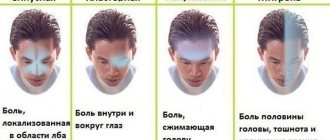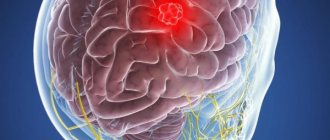What reason
There is no single cause of pain in the head when bending over: the symptom appears with neurological, colds and heart ailments.
- Sinusitis is inflammation of the maxillary sinuses (small spaces located in the upper jaw). The disease is accompanied by swelling of the mucous membrane, which fills the volume. Due to poor ventilation, conditions are created for the proliferation of bacteria, which aggravates the general condition of a person. Difficulty in nasal breathing and general intoxication syndrome are added to the symptoms: fatigue, nausea, lack of appetite.
- Frontitis is inflammation of the frontal sinuses.
- Migraine. Most people who complain of headaches when bending over suffer from migraines. Cephalgia with migraine goes away in a few hours, while with inflammation of the sinuses the unpleasant sensations last a week or more.
- Tumors. Throbbing pain in the head when bending over may be a consequence of the development of tumors in the soft structures of the skull. Usually the condition worsens in the morning and evening, it is accompanied by nausea, vomiting, and increased blood pressure. The pain intensifies when trying to get out of bed. The emotional state changes: patients complain of irritability, fatigue, tearfulness and low mood.
- Pain when moving and bending can occur with the development of allergies, for example, with angioedema. The acute condition is accompanied by swelling of the soft tissues of the face. At this time, the cranial spaces are filled with mucus, the membranes increase in size and compress neighboring structures - pain appears.
- Hypertonic disease. Against the background of constant high blood pressure, the patient may complain of pain in the head when coughing and bending over. In this case, the patient feels fullness and pulsation in the head. The disease is accompanied by dizziness, weakness, fatigue, damage to the heart, brain, liver and kidneys. In patients with increased pressure, the face turns red and shortness of breath appears.
- Diseases of the musculoskeletal system: osteochondrosis of the cervical vertebrae. Due to general degenerative processes in the spine, surrounding tissues suffer: muscles, nerves, blood vessels. Thus, blood flow is disrupted and the conduction of nerve impulses deteriorates, causing muscle nutrition and blood delivery to the brain to suffer. Most often, patients complain of pain in the back of the head and temples.
- Tension cephalgia. The disease is accompanied by pressing pain around the head: the forehead, crown, and temples hurt. 30 minutes after the onset of the attack, unpleasant sensations cover the entire head. Patients say it feels like their skull is being squeezed in a vice.
- Barotrauma. The internal cavities of the skull communicate with each other, their own pressure arises there, and it is sensitive to atmospheric pressure. Divers and all those who have dived to depth are familiar with this concept. Already on land, people with barotrauma report complaints of pain in the head when bending over.
Other reasons:
- a sharp increase in intracranial pressure;
- inflammatory diseases of the brain and membranes: encephalitis, meningitis;
- specific female conditions: menstruation, pregnancy;
- withdrawal syndrome after drinking alcohol or drugs.
Psycho-emotional reasons:
- sleep disturbance;
- exhaustion of the body after prolonged work;
- depression;
- smoking;
- passive lifestyle;
- weather sensitivity.
Headache when coughing: causes and treatment
Headache when coughing is a common complaint of patients when visiting a specialist. According to medical statistics, a similar symptom occurs in 80% of cases. This phenomenon is especially often observed during attacks of dry, unproductive cough.
The mechanism of pain development is based on a transient but sharp increase in intracranial pressure. The result is an excessively strong effect of cerebrospinal fluid on the dura mater. The brain itself cannot hurt; the blood vessels and nerve endings that penetrate the cerebral structures hurt.
Despite the seeming harmlessness of this condition, this is not entirely true. In clinical history, there are cases where, as a result of intense coughing, a patient suffered a stroke. This can be fatal. What can cause a headache when coughing and how to cope with this condition?
Pain in the head when coughing can occur for a variety of reasons. What is the most common?
- Smoking cigarettes and other tobacco products. In patients who have a decent history of smoking, coughing occurs as a habitual reaction and a natural result of a bad habit. However, another factor comes into play here. Smokers often develop secondary cerebral atherosclerosis. What this entails is already clear. A cough provokes a headache in the temples, to the extent that the amount of cerebrospinal fluid increases sharply and the blood vessels narrow. The syndrome, therefore, has a mixed character: on the one hand, intracranial pressure increases, and on the other, blood pressure increases. This is the most dangerous clinical situation.
- Sinusitis. Inflammatory lesions of the maxillary sinuses (nasal sinuses). It is characterized by a runny nose, severe cough with a productive component of a false nature. Headache develops as a result of a prolonged increase in blood pressure, its localization is mainly in the forehead.
- Bronchial asthma. Characterized by paroxysmal course. Often during the next attack, the cough is so intense that stenosis of the cerebral arteries and impaired nutrition of cerebral structures are noted. As a result of an increase in blood pressure and a change in the nature of oxygen and nutrient metabolism in the brain, severe headaches develop in the back of the head and eyeballs. It lasts from several minutes to an hour.
- Diabetes. It occurs relatively rarely as a culprit. Pain occurs as a result of pathological changes in the arteries.
- Cardiovascular diseases lead to constant headaches on the right and left side of the forehead. Cough is only a temporary cause of discomfort, a special case. Discomfort occurs spontaneously. The duration of pain varies. As a rule, it lasts exactly as long as the attack of high blood pressure occurs.
- If you have a headache when coughing, the reason may lie in increased sensitivity to weather conditions (the so-called weather dependence). Cough acts as a kind of trigger for a pathogenic symptom. The main factor influencing the intensity of pain is a decrease in the tone of vascular structures.
- Colds, acute respiratory pathologies. They have a constant headache. This is a typical sign of intoxication in the body. Coughing only increases discomfort as intracranial pressure increases.
- Other circulation disorders of the cerebrospinal fluid (brain fluid). In all cases, they provoke an increase in intracranial pressure.
- Brain tumors. Gliomas, germinomas and other neoplasms localized in the chiasmal-sellar region and in the region of the third ventricle. They cause intense headaches on their own. When coughing, the syndrome only intensifies.
- Vertebrobasilar insufficiency. Insufficient circulation of blood supplying the occipital lobe of the brain and the cerebellum. May cause severe pain in the head when coughing.
The list of reasons is incomplete. All diseases accompanied by a prolonged cough cause the described symptom. If when you cough it goes to your head, you should look for the culprit among the described ailments.
Associated symptoms
Symptoms directly depend on the nature and degree of pathological changes. Some diseases are accompanied by an increase in body temperature. Hyperthermia occurs relatively often and always indicates an infectious viral genesis of the disease.
Its level varies from subfebrile condition (when body temperature does not exceed 38 degrees Celsius), to febrile condition (up to 39.1 degrees) and even more.
Pyretic indicators indicate in favor of a severely ongoing pathological process. Meningitis, pneumonia, purulent bronchitis and other ailments are possible.
In addition, the following symptoms are possible:
- Weakness, drowsiness, feeling of weakness and weakness in the body. Typical manifestations of general intoxication of the body. The more severe the process, the more pronounced the symptoms.
- Runny nose, changes in the nature of nasal breathing. There may be an outflow of mucous exudate or purulent exudate. There is a symptom of sinusitis and sinusitis.
- Pain when breathing, shortness of breath, suffocation, lacrimation. Typical manifestations of allergic diseases, pneumonia, bronchial asthma, etc.
If no symptoms other than cough and secondary headache are observed, there is most likely no evidence of organic pathology. You should look for the original source of the problem in smoking, weather dependence and similar processes. But an accurate diagnosis can only be made as a result of an objective diagnosis.
Diagnostic measures
Coughs with pain radiating to the head are treated by specialist therapists. In some cases, you may need help from a pulmonologist (lung specialist) or neurologist. Cardiovascular pathologies are the prerogative of cardiologists.
At the initial consultation, a general examination of the patient is carried out. The doctor interviews the patient, studies the nature of the complaints, their age, duration, and all accompanying symptoms. It is important to collect anamnesis in order to identify the possible source of the problem. Accordingly, it is necessary to ask questions regarding diseases suffered previously.
Objective studies, including neurological and others, are of great importance.
- Encephalography. It is carried out to identify changes in brain activity. This is an absolutely necessary study, which is prescribed in all cases.
- MRI of the brain. If there is no evidence for a particular disease, one should look for tumors and other changes in cerebral structures. This is the only method for identifying problems with the membranes and structures of the brain, but due to its low availability, such a study is prescribed relatively rarely.
- X-ray of the lungs (chest organs). Makes it possible to recognize pneumonia and bronchitis of various origins. They may well be the culprits of an intense cough.
- Dopplerography of the vessels of the vertebrobasilar region. Necessary for assessing the speed of blood flow in the occipital lobe of the brain.
Treatment
The main goal of therapy is to treat the underlying disease. You can use analgesics and the pain will go away, but this is a temporary solution that does not eliminate the cause.
Sinusitis and sinusitis are diseases more often of a bacterial nature, so the clinic prescribes antibiotics and anti-inflammatory drugs. In addition to medications, physiotherapeutic procedures are performed: UHF, facial tissue massage, nasal rinsing with saline solutions.
For acute allergies, prednisolone and adrenaline are administered intravenously. For controlled allergies - antihistamines of later generations: suprastin, diphenhydramine. All other diseases are treated symptomatically or surgically.
Source: sortmozg.com
Etiology [causes]
Men over forty years of age are most susceptible to headaches when coughing. They suffer from this four times more often than women.
The nature of the pain is as follows:
- the attack is short-lived, from several seconds to several minutes. Maximum duration – half an hour;
- very strong and intense pain;
- in most cases, diffuse pain (in the forehead, temples, back of the head simultaneously or in turn), but in a third of cases it is unilateral. At times it becomes chronic;
- Most often my head hurts when I cough.
Experts call the second most common lesion of the peripheral nerve in the neck area. In other words, cervical neuralgia. Its peculiarity is that it manifests itself not only during coughing, but also when turning or tilting the head, as well as any other sudden movement. Neuralgia is mainly caused by drafts.
In the presence of cervical osteochondrosis, the source of pain is concentrated in the occipital part of the head. The unpleasant sensations are accompanied by tinnitus, dizziness, and attacks of lightheadedness (nausea).
This is due to reasons such as:
- high pressure in the blood vessels of the brain;
- lifting heavy things, sneezing, sudden bends, squats and other physical activities;
- the body's reaction to acute respiratory viral infections and lower respiratory tract infections;
- smoking;
- allergies to dust, smoke, pollen, etc.;
- bronchial asthma;
- changes in the structure of the brain.
Smoking disrupts the functioning of the heart and blood vessels. The heart rate increases and blood pressure rises. The body signals nicotine poisoning through cough, headache, nausea, shortness of breath and other signs.
Another reason for combining a headache with a cough is weather dependence. You need to understand that sensitivity to weather changes in most cases comes “together” with other pathologies, such as:
- heart and vascular diseases;
- diseases of the musculoskeletal system;
- genitourinary diseases;
- diseases of the nervous system;
- weakened immunity.
It is most difficult for those diagnosed with vegetative-vascular dystonia or congenital heart disease. Persons with diseases of the respiratory system are also susceptible to dependence of their well-being on changes in atmospheric pressure.
An asthma attack begins with a feeling of pressure in the chest and a dry cough. It is difficult to breathe, wheezing and whistling appear. Due to frequent breathing, a person experiences oxygen starvation, which causes blood pressure to rise. The attack ends with a wet cough and thick sputum. If the wheezing and whistling stop, but no wet cough occurs, this is a signal that the person needs urgent resuscitation due to a blocked airway.
Any cold is accompanied by a headache and cough. Coughing clears phlegm from the airways and lungs, which promotes recovery. Such a headache appears due to poisoning of the body, and intracranial fluid presses on the lining of the brain. In this situation, this is normal, as it is associated with the disease. That is, with bronchitis, sinusitis, sinusitis or ARVI, a short attack of pain in the head during the so-called “clearing of the throat” is not scary.
If a person has a chronic cold - sinusitis or sinusitis, then the forehead may hurt during the slightest cough. This is because chronic sinusitis is a constant inflammatory process in the sinuses of the forehead and nose; accordingly, the mucous membranes are also constantly irritated. The accumulation of purulent masses and sputum when coughing gives pain to the head.
With chronic bronchitis (which in itself is dangerous because it can develop into bronchial asthma), coughing attacks are so strong that they bring a person to vomiting. This no longer causes a short-term attack of pain, but a real long-term headache. People prone to migraines run the risk of coughing and having an unplanned attack.
If a person has Arnold-Chiari syndrome, headache from coughing and sneezing is one of the symptoms. Be sure to consult and then be examined by a doctor. If the syndrome exists, it means the brain is not developing correctly, and the cerebellum is deformed. Because of this, cerebrospinal fluid (intracranial fluid) circulates incorrectly.
The difference between an allergic cough and a cold is as follows:
- always appears accompanied by a headache as a result of exposure to an allergen;
- lasts more than three weeks;
- not accompanied by weakness, fever, chills;
- companions are itching, lacrimation, runny nose;
- The cough is mostly dry.
Primary cough headaches do not require intensive drug treatment in most cases. However, it can also signal serious pathologies.
Why does coughing give you a headache?
Before prescribing treatment, it is necessary to determine the main cause of pain. Treating the symptoms will not give the desired result. The pain will appear again, and the body’s condition will worsen significantly.
Allergy
One of the main causes of headaches when coughing is allergies. Coughing can be dry and suffocating. The pain increases significantly when playing sports or bending, since the allergen triggers biochemical reactions that occur in the brain. In addition to a suffocating cough and headaches, skin rashes, watery eyes, runny nose, and itchy skin appear. Treatment should be aimed at eliminating foods, medications, and chemicals containing allergens.
Meteor dependence
In certain groups of people, the body reacts sharply to changes in ambient temperature and atmospheric pressure. In this case, joint, muscle, and headaches may appear. The latter are localized in the occipital region. When coughing, the pain intensifies. When blood pressure drops, muscle pain, drowsiness, and lethargy appear. You can more accurately determine the connection between headaches and changes in atmospheric pressure by tilting your head. If the pain intensifies, then the cause is weather dependence.
Colds
Headaches accompanied by a wet or dry cough may occur due to the development of colds. In this case, coughing is considered a protective reaction of the body to mucus accumulated in the lungs. It is important to understand what disease has affected the body in order to prescribe appropriate treatment:
- ARVI. The condition is rapidly deteriorating. Muscle weakness, lethargy appears, and body temperature rises to 38 degrees. There is a cough, nasal congestion, dizziness, and headache. Symptoms appear quickly and simultaneously.
- Cold. The condition is slowly deteriorating. Nasal congestion appears immediately, coughing may occur after a day. The temperature does not rise immediately. Weakness and dizziness occur.
- Flu. This disease develops rapidly. The process begins with intoxication, in which the body temperature quickly rises to 40 degrees. Coughing occurs after two days.
Diagnostics
When a patient complains of a headache when coughing, first of all you need to find the cause of its occurrence. The main thing that should be ruled out is the presence of a tumor inside the skull.
The main activities will be:
- taking anamnesis;
- conducting laboratory research;
- ultrasound examination of cerebral vessels (brachiocephalic and intracranial);
- measuring the speed of blood flow in the specified vessels;
- magnetic resonance imaging of the head.
Treatment
Modern diagnostic methods make it possible to identify dangerous diseases and treat them. Therapy depends on what diagnosis is established for the patient based on research results.
If a tumor is detected in the brain, surgical intervention and a subsequent long period of treatment and recovery are necessary. If an aneurysm is confirmed, emergency surgery will likely be required.
If no pathologies are detected, the doctor prescribes an anesthetic. For example, “Ibuprofen”, “Nurofen”, “Analgin”, “Spazgan”, “Novigan”, “MIG”. Do not exceed the dosage recommended by a specialist, even if the pain does not go away. It is better to seek advice again and, perhaps, another, more suitable medicine will be selected.
Compresses and herbal teas are used in conjunction with the treatment plan, not in place of it. Any other folk remedies should be used carefully and in moderation. And, of course, there is no need to self-medicate and take handfuls of pills instead of seeing a doctor.
Relieving pain using traditional medicine
Relieving pain in the head when coughing is possible only in two cases: if the pain is too severe and the patient is unable to see a doctor at this time and with full confidence that the cause of such pain is a runny nose or another cold. The safest and most neutral in such situations is a compress, which can be done in three ways:
- A piece of cloth soaked in vinegar is applied to the forehead and temples and held until the cloth becomes warm. After this, the compress is moistened again in vinegar and the procedure is repeated.
- A “cold compress,” which only requires cold water, is also applied to the forehead and temples. To prepare such a compress, you simply need to moisten a piece of cloth or gauze in water, to which you can add ice.
- A salt compress is very effective, for the preparation of which a saline solution is used (half a tablespoon of ordinary table salt is dissolved in a glass of water).
An alternative means for preparing a compress can be essential oils, for example, mint or menthol.
Such gentle methods are not always effective, so in parallel with the use of compresses, you can drink painkillers available in your home medicine cabinet, which, if they are unavailable, can be replaced with valerian root. This remedy is not a pain reliever in itself, but it relieves pain. But you need to take not the remedy itself in its pure form, but an infusion, for the preparation of which 20 grams of herb must be poured with 300 grams of boiling water.
The product is boiled for 15 minutes over low heat and then infused for an hour. You need to take the infusion daily, half an hour after eating, two tablespoons until the pain when coughing disappears.
Other popular folk remedies include:
- herbal teas with the addition of mint, chamomile and thyme;
- fresh juice of viburnum berries, which should be drunk before each meal, three tablespoons;
- cabbage leaves, which are applied to the diseased area and fixed with a scarf or bandage for one hour;
- Instead of cabbage, you can take aloe, the leaves of which are first cut flat and applied to the diseased areas with the side that secretes juice.
If pain in the head when coughing is caused by osteochondrosis, the treatment should focus on herbal infusions, the basis of which is better to use thyme, and depending on your tastes and capabilities, this remedy can be combined with rose hips, plantain or lemon balm. Thyme is mixed with any of these components in a 1:1 ratio and poured with boiling water. If you take one tablespoon of each plant, 400 ml of boiling water will be enough to prepare the product, in which the herbs should be infused for at least an hour. The finished drink should be drunk twice a day, it is advisable to maintain equal intervals between doses.
Sinusitis also refers to diseases in which pain during coughing attacks can be relieved independently. In this case, inhalation will help. To do this, prepare a product based on chamomile and calendula, which are mixed in equal proportions. Taking one teaspoon of these dried crushed herbs, pour three glasses of boiling water over them. While the infusion has not cooled down, inhalation is carried out (usually this procedure takes up to ten minutes). For subsequent inhalation sessions, a new portion of the product is prepared each time.
Practice shows that a headache when coughing is quickly relieved with a propolis-based remedy:
- Twenty grams of this substance is mixed with one hundred grams of pure medical alcohol (if it is unavailable, high-quality vodka can be used).
- The mixture must be thoroughly mixed until a homogeneous mass without lumps is formed.
- The finished product in an amount of no more than forty drops is spread on a small slice of rye bread, which is eaten.
Such simple recipes do no harm, but for serious illnesses they are not particularly helpful. In addition, such folk recipes are dangerous because when eliminating pain, they can only muffle, but not eradicate the disease itself. Considering that in such situations, delay can lead to serious consequences, you should not rely solely on traditional methods. They should be used only as a temporary measure, while simultaneously undergoing the course of treatment prescribed by the doctor.
Prevention
Measures to prevent headaches after coughing depend on what caused it. If this is an allergy, then you should, if possible, prevent contact with allergens and always carry antihistamines with you. If you have a bronchial asthma, it should always be in a person’s pocket or bag.
If you have a headache in the forehead due to smoking, then you will have to give up this bad habit.
Prevention of colds will include measures known to everyone, but no less effective:
- hardening (with gradual daily cooling of the water temperature for dousing by 1 degree);
- walking in the fresh air;
- physical activity, sports;
- proper nutrition;
- rejection of bad habits;
- healthy sleep at least 7-8 hours daily;
- taking vitamins (agreed with the attending physician) during periods of active ARVI.
Remember, if you have a headache or cough, you should avoid self-medication and wait. Only contacting a specialist and following his recommendations will help cure the disease and restore health.
Source: simptom.guru
How to get rid of headaches when coughing
After diagnosis and determination of the cause of pain, the doctor prescribes appropriate treatment. This may be the use of purchased medications or folk remedies.
Drug therapy
Before starting drug treatment, you should consult with your doctor. An incorrectly selected dosage of the drug can cause a worsening of the condition. To improve your well-being, you can use the following medications:
- Ibuprofen, Citramon - prescribed in the presence of inflammatory processes.
- Baralgin, No-Shpa are antispasmodic drugs. Used when acute pain occurs.
- Tubocurarine is a muscle relaxant. Relieves pain caused by tension in the neck and spinal muscles.
- If the symptoms are associated with the presence of infectious, viral, or bacterial diseases, the attending physician prescribes antibiotics or antiviral drugs.
- To reduce the number of coughs, lozenges and cough sprays are additionally used.
It is important to strictly follow the dosage prescribed by the doctor.
Treatment with compresses
You can get rid of headaches with the help of medicinal compresses. These include:
- Cooling compresses. Effectively relieves pain from allergic reactions or migraines. To do this, you need to put several ice cubes in a plastic bag, wrap it in a thin towel and apply it to the temple area.
- For pain associated with muscle tension, warming compresses are used. To do this, fill the heating pad with hot water and apply it to the back of the head. The muscles relax, oxygenated blood flows to the brain area.
- Salt compress. The gauze needs to be moistened in a saline solution (200 ml of water plus half a tablespoon of table salt). Fold the fabric into 4 layers and wrap it around your head.
- Vinegar-based compress. The gauze is soaked in a purchased mixture, folded into 3-4 layers, and applied to the forehead. You need to keep the soaked bandage until it warms up.
Before using compresses, it is important to accurately determine the cause of headaches. Otherwise, you can harm the body. In the presence of malignant neoplasms or internal bleeding, the patient is sent for urgent surgery.
Medical indications
If your head hurts when bending over, you shouldn’t panic right away. Sometimes the process is based on non-medical factors, including:
- frequent, intense nervous strain;
- stressful situations;
- long-term depression;
- chronic fatigue.
If you have a headache, the cause may be alcohol or drug addiction. Some medications may cause pain. In this case, pain is a side reaction of therapy.
Medical etiological factors
Throbbing pain often bothers patients. The etiology of headache may be related to:
- with allergic reactions;
- with neoplasms of the nasal cavity;
- with asthmatic syndrome;
- with seasonal exacerbations;
- with consequences of migraine;
- with spondylosis;
- with osteochondrosis.
Throbbing pain occurs most often. It can be provoked by sinusitis and other pathologies of the paranasal sinuses. Sinusitis is a severe inflammatory lesion of the paranasal sinuses.
The process often occurs due to untreated influenza or a viral infection, which is complicated.
Sinusitis can manifest itself in the form of frontal sinusitis, sinusitis, or sphenoiditis. In this case, pulsating pain in the head always develops.
How to suspect the development of sinusitis? There are a number of specific signs characteristic of sinusitis:
- a feeling of pressure in the forehead, temples or eyes;
- mucous discharge from the nose, especially in the morning, often mixed with pus;
- increased body temperature;
- throbbing pain in the face upon palpation;
- sharp pain in the head when bending over;
- aching attacks of pain when lying down;
- malaise;
- chills;
- fever.
Sinusitis almost always accompanies viral infections. It all starts with a runny nose, and there is throbbing pain when bending down.
When damaged, an intense inflammatory process occurs in the nasopharynx. Swelling of the tissues in the nasal area develops, which interferes with normal air movement.
Mucus tends to stagnate - microbes accumulate in it, and purulent contents appear. Because of this, pressure arises in the nasal area and unpleasant sensations appear.
This causes pain when tilting the head. The pain can radiate to the upper jaw and teeth.
With excessive accumulations, severe pain and pressure develops in the maxillary sinuses. This is why self-medication in such cases is unacceptable.
Why does soreness occur in the forehead? The most common cause of such discomfort in the forehead is sinus damage.
It occurs due to excessive accumulation of pus in the affected areas of the nose. In this case, to normalize the condition, only specialized medical care will be required.
Self-medication will not bring the slightest result. Ignoring medical care will only lead to a deterioration in health and will transform the pathology of the nasal area into a chronic form.
The standard list of medical prescriptions includes:
- an antibiotic that acts against this infection;
- drugs against swelling (their use can lead to increased pain in the head and nose, so they should be used only on the recommendation of a doctor);
- antihistamines that reduce swelling.
In some cases, an additional pain reliever or decongestant is used to minimize headaches and constrict blood vessels.
You should not ignore the benefits of physiological procedures, mud treatment, and inhalations.
It has been proven that timely treatment of sinusitis will not cause a number of complications, including brain swelling, meningoencephalitis, meningitis.
Successful therapy is possible only after a comprehensive examination. Complex therapy for sinusitis has individual characteristics.
Hypertensive disease is another reason that provokes the clinic in question. It has a chronic course and a tendency to relapse.
The clinical picture of the disease includes sharp increases in blood pressure:
- shortness of breath;
- the patient has a headache in the back of the head;
- possible dizziness;
- weakness, malaise.
Hypertensive people are more likely than others to have problems with excess weight. If your head hurts from increased blood pressure, you should not delay treatment.
In severe cases, the disease can cause a stroke or be fatal.
Hypertensive patients suffer from constant surges in blood pressure. Moreover, the slightest tension provokes severe headaches when bending over. Bending over causes pain in the back of the head.
Often discomfort begins to bother you immediately after waking up. To prevent attacks, it is useful to walk in the fresh air and normalize weight.
Specific drug treatment is selected by the doctor on an individual basis. A number of factors are taken into account, the response to previous therapy.
Migraine develops against the background of stress, overwork, and hereditary tendencies. In addition to pain in the head when bending, patients complain of lacrimation, photophobia, and nasal congestion.
Additionally, the patient complains:
- for thirst,
- for swelling due to drinking large amounts of liquid;
- to irritation.
This pathology provokes episodic pain in the head, headache when bending over. During an attack, intense thirst occurs, the patient drinks a lot of liquid.
Therefore, a clinical picture of severe swelling appears.
Migraine etiological factors include:
- stressful situation;
- complicated heredity;
- overwork;
- drastic change in weather conditions;
- long or too short sleep;
- consumption of certain foods - chocolate, nuts, smoked meats, beer, wine, cheeses.
Treatment of the disease should be carried out under the supervision of a neurologist. Only then can we talk about effective treatment. Self-medication can only worsen the condition.
Osteochondrosis of the cervical vertebrae occurs due to a sedentary lifestyle or sedentary work. Provokes:
- crunching in the neck;
- Patients have headaches when bending over or doing physical activity;
- aching pain in the head that radiates to the shoulders and arms.
The nature of the pain can be episodic, prolonged, or chronic.
To minimize the frequency and intensity of pain, physical exercises are used: the head is turned in different directions, tilted from the right side to the left, and looking up.
Allergic reactions provoke pain in the neck and head at the slightest bend. Deterioration occurs almost immediately after consuming a dangerous product.
Any contact with an allergen provokes an attack. If a person has a headache due to allergies, then soon lacrimation will also occur, pain in the eyes, and swelling of the larynx will occur.
Almost always, allergies cause a rash. Only timely medical care can normalize the condition.
Allergy headaches appear suddenly. Headache when bending down in the forehead area. The duration of the attack is several days.
First aid for allergic diseases:
- absolute peace;
- bed rest;
- fermented milk and vegetable diet.
For prevention, it is important to exclude any contact with allergens. On the recommendation of the doctor, procedures are prescribed: the introduction of calcium chloride, sculpting mustard plasters on the neck area, hot foot baths.
Damage to the cervical elements is a fairly common cause of headaches when bending over.
Mostly pain develops in the presence of spondylitis, subluxations, stretch marks of the muscular or ligamentous apparatus.
Drafts and various curvatures of the spine also become a common cause of headaches.
Every year the disease will only progress, causing more and more attacks and more intense pain at the slightest bend.
Staying in one position for a long time is an important reason why your head hurts. This is all due to poor blood flow and severe numbness in the body.
Severe intoxication of the body can be considered an important factor in the development of problems.
Such poisoning greatly harms the body. First of all, the elements of the nervous system are affected; pain in the head occurs at the slightest bend.
Tension disorders are considered a separate factor in the development of pain when bending over. They arise against the background of prolonged stress and anxiety.
In this case, there are frequent presyncopes that occur suddenly. Treatment for this condition requires sedatives and sometimes antidepressants.
An important etiological factor is inflammatory damage to the vascular elements of the brain, atherosclerotic damage.
Temporal arteritis, associated with severe damage to the vascular system, is a common cause of headaches when bending over.
Severe depression, weight loss, sleep problems and blood pressure surges also occur. The disease predominantly develops in elderly people or in those who often suffer from infectious diseases and weakened immunity.
Cluster pain is included in a separate category. The pathology predominantly affects representatives of the stronger sex.
This is a periodic disease that is always accompanied by shortness of breath and runny nose. A pronounced loss of strength, which often leads to loss of consciousness.
If your head hurts when bending over, you may suspect high intracranial pressure. It is localized in one of the areas of the brain.
In this case, problems with speech and impaired coordination of movements additionally arise. Vision deteriorates, and in some cases nausea and uncontrollable vomiting even develop.
Chest pain when coughing - what could be the causes?
Hello dear readers. We usually associate the occurrence of a cough exclusively with colds, and we cannot even imagine that this symptom could mean anything else.
It is interesting that for quite a long time a person can attribute the symptoms that appear to a cold, although in fact, already at this time a serious disease will be developing in full swing in his body.
If the cough does not go away some time after the start of active treatment prescribed by the doctor, then this fact will already be a cause for concern.
In fact, any other disease of the respiratory system can simply masquerade as a cold due to the fairly strong similarity of symptoms. Pain can appear both during coughing and independently of it, so such features should be taken into account, because they will help establish an accurate diagnosis.
A person may feel discomfort not only in the chest, but throughout the entire torso, since pain has the ability to be reflected. Even the temperature may rise, which usually indicates an inflammatory process.
Why is coughing accompanied by pain? You should not be too indifferent to such a symptom, because it can signal the development of a serious disease in the body. Cough can be both wet and dry, each of which is characteristic of a particular disease.
- In some cases, such a symptom is also accompanied by pain, the localization of which is usually:
- - sternum;
- - left or right side;
- - back;
- - head (in the temple area);
- - under the ribs on all sides.
Chest pain when coughing - TOP 14 reasons
- Quite often, a painful cough is accompanied by other symptoms that are common to many diseases: increased body temperature, shortness of breath, expectoration, snot, and general weakness in the body.
- It is thanks to these symptoms, as well as the location of the pain, that the cause of the cough can be determined.
- Several symptoms may appear at once with a certain disease, and the main one will, of course, be painful coughing attacks.
- Pneumonia. Typically, pneumonia is accompanied by elevated body temperature, as well as periodic tingling throughout the chest area. It is characterized by a dry cough, which does not involve the discharge of sputum. Their presence in the lungs leads to the development of the disease.
- Pleurisy. This disease is one of the possible consequences after pneumonia. The inflammatory process spreads to the thin membrane of the bronchi, which is essentially its cover. For quite a long time, you can observe a strong cough, the consequence of which is a disruption of the usual breathing process. Low-grade fever is also typical, not exceeding 37 degrees. In addition, at night a person may sweat quite a lot, and the pain in the supine position is significantly reduced.
- Bronchitis is a complication of simple ARVI. It is characterized by a significant increase in body temperature, weakness and a wet cough. With proper therapy, acute bronchitis can be treated quickly enough, since there are no problems with the removal of sputum. But chronic bronchitis is accompanied by coughing attacks at night, while during the day a person can only cough occasionally.
- Tuberculosis. This disease can hardly be confused with any other, because a person experiences excruciating pain in the sternum. Low-grade fever can last more than two weeks. The cough is quite strong, and it manifests itself in the form of severe attacks, while sputum is constantly excreted, but it will definitely contain blood. It is this symptom that can alert a person, because it is what makes him go to the doctor.
- Infectious diseases. Typically, pain occurs precisely because of excessive accumulation of lactic acid in the intercostal muscles. This is due to the fact that these are the muscles that tense the most when coughing. The temperature can rise quite strongly, and it is usually accompanied by weakness and chills.
- Pneumothorax. The disease occurs due to any mechanical damage to the lungs, for example, a rib fracture. The patient suffers from excruciating pain with every deep breath of air. The fact is that during inhalation, the lungs, due to their openings, release air that enters the abdominal cavity. Thus, it puts pressure on other internal organs.
- Pericarditis is inflammation of the lining of the heart. Dry pericarditis is accompanied by increased pain when coughing, taking deep breaths, sneezing, and even light pressure on the chest.
- Oncology. The occurrence of a malignant tumor is characterized by quite severe pain, so patients are often saved only by strong painkillers. The tumor can also affect the spine, so when coughing a person also feels pain in this area. As a rule, only in the later stages does the pain intensify significantly.
- Disturbances in the usual mobility of the chest , as well as the part of the spine adjacent to it. The disease occurs as a result of a spinal injury or the appearance of pleural tumors.
- Chest injuries may also be accompanied by pain not only when moving, but also when coughing. The situation becomes especially complicated if the broken bones heal on their own, without the help of doctors. Thus, a person may experience pain throughout his life.
- Musculoskeletal diseases. For example, osteochondrosis of the chest causes slight pain when coughing. Therefore, you should not ignore this disease, because it can lead to some complications.
- Neuralgia is characterized by fairly severe chest pain , which can easily be confused with a symptom of any respiratory disease. But it consists in damage to the nerves, but not to the lungs. Pain is constantly present, which makes it psychologically difficult for a person to cope. And it intensifies during movements, deep breaths or coughing.
- Shortening of the interpleural ligament. A cough occurs, which usually worsens with deep breathing and exercise, and even when the person begins to speak. Stitching pain can occur with every deep breath, since at this moment the diaphragm is activated, to which the ligament is attached. And it shortens due to the inflammatory process, so it is better to prevent its occurrence.
- Diseases of the urinary system. Quite often, pain from renal colic can even be reflected in the chest. Therefore, if you feel severe pain in the lower back, along with pain in the shoulder blades, then you should not consider it as a separate symptom. Most likely, this is simply a reflection of the pain that has arisen in the kidneys.
What is the problem with divers?
People in this profession are often prone to developing headaches. All changes and damage to the body occur during a sharp change in atmospheric pressure.
If you experience headaches, something has gone wrong. Pain with dizziness occurs due to damage to the nasal sinuses.
Sudden ascents or descents can lead to ruptured eardrums, embolisms and the death of the diver. In such a profession, following the rules is an important condition for a safe rise to land.
Associated symptoms
Along with pain during coughing, other clinical signs are also likely:
- increased blood pressure;
- dyspeptic disorders (nausea and vomiting);
- insomnia, anxiety;
- manifestations of intoxication (weakness and chills, apathy, dizziness);
- runny nose, nasal congestion;
- neurological symptoms: focal and cerebral;
- respiratory failure.
If heaviness in the head accompanies meningeal signs (stiffness of the neck muscles) and fainting, the development of inflammation of the substance or membranes of the brain is possible.
General recommendations for diagnosis and therapy
After the first episode of headache, it is better to get examined immediately. First of all, you need to consult a neurologist, cardiologist, or ENT specialist.
Only after a detailed survey and examination will a specialist be able to make a preliminary diagnosis and prescribe a set of diagnostic procedures to clarify the diagnosis.
In most cases, complex diagnostics are prescribed, including instrumental and laboratory research techniques.
Therapy is selected based on the final diagnosis. A comprehensive course of treatment is selected for each patient individually, taking into account all his characteristics.
Source: 1golovabolit.ru
Causes of headaches
The main causes of pain in the temporal zone or in the occipital region can be determined after diagnosis; they can be as follows:
- Smoking. As soon as nicotine enters the blood, the blood vessels begin to narrow sharply, and as a result, the pressure increases. Therefore, at the first puffs a person feels dizzy, but after a short time the condition returns to normal. Smoking is often accompanied by a cough, as tobacco smoke irritates the bronchi.
- Allergens - if they get on the mucous membranes, irritation begins and a strong dry cough appears. The result of this phenomenon is swelling of the maxillary sinuses. Breathing worsens, insufficient oxygen reaches the brain, which provokes pathology.
- Meteor dependence. There are many people in the world who are dependent on fluctuations in atmospheric pressure. Infants and the elderly are especially susceptible to this. Your head may hurt when the weather changes, and coughing only makes the situation worse. Typically, pathology forms in the occipital and temporal regions. This is due to vascular spasms. When the pressure drops rapidly, dizziness begins.
- Arnold-Chiari syndrome. This is a hereditary pathology - the cerebellum does not work correctly, coordination of movement is impaired. One of the formation factors is the woman’s abuse of alcohol and tobacco during pregnancy. Excessive use of drugs leads to intoxication of the body as a whole, which enhances the development of the syndrome. The disease is incurable - the patient’s condition is maintained by constant medication. When coughing, he experiences discomfort in the occipital area, which occurs along with bronchospasms.
- Sinusitis is suppuration of the nasal sinuses, which causes coughing. Pathology occurs with sinusitis, when even bending down causes vascular spasms. This is explained by the presence of a purulent component in the tissues and a lack of oxygen, which affects the brain. With frontal sinusitis, pain may appear in the area of the frontal part of the head.
- Osteochondrosis is instability of the cervical spine, discomfort occurs when coughing and overwork.
- Neuralgia is pain that shoots and pulsates. When coughing, it only intensifies and becomes unbearable.
If, with a headache, the patient feels nauseous, vomiting, and weakness, but the body temperature is not elevated, this is most likely the result of general intoxication of the body, which often accompanies stomach infections.
There is a more serious cause of this pathology - oncology, with this disease pain can occur in any part of the head. Neoplasms grow for a long time without producing any symptoms. As the tumor grows, the patient experiences more frequent spasms, which are aggravated by coughing, sudden head turns, bending, and sneezing.
Folk remedies
If you experience pain when coughing, you can also use traditional medicine. There are several simple recipes that can relieve headaches and cramps:
- A compress is considered an excellent treatment for headaches during coughing. Vinegar is used for these purposes. You need to take a small piece of cloth or gauze, soak it in vinegar and apply it to your temples and forehead. When the compress is warm, you need to soak it in vinegar again. If dizziness occurs, the procedure should be stopped immediately;
- Cold compresses are often used. This method of therapy has a vasoconstrictor effect, allowing you to quickly eliminate discomfort. After the compress has warmed up, it is necessary to cool the fabric again by applying it to the forehead. You can use ice wrapped in polyethylene and a piece of fabric;
- An effective remedy for combating pain in the head when coughing is herbal tea. You can make this tea from mint, thyme, chamomile and other herbs. Such teas have an anti-inflammatory and tonic effect;
- To treat pain when coughing in the back of the head, you need to use viburnum berries. To do this, you should mash the berries with grains, squeeze the juice out of them and drink three tablespoons three times a day before meals;
- Often, people who experience a headache when coughing use cabbage leaves to relieve it. A cabbage leaf must be fixed on the back of the head and frontal part for one hour.
Doctors do not recommend taking medications for a long time, since they are not able to cure the cause of pain, but only aggravate the general condition of the body. It is especially not recommended to try to “kill” a headache with medications if it is sharp and constant, because this may indicate the presence of a serious illness.
Sometimes, the pain can radiate to the forehead and the back of the head, while the patient has no runny nose or cough at all. This phenomenon may indicate the presence of a tumor, and it can not only be benign, it can also be cancer, which is deadly.
A general examination will not allow you to detect this kind of ailment in person. In this case, only certain tests and computer intervention will be effective, allowing you to accurately determine the nature of the tumor and its location.
The video in this article will tell you why headaches are so dangerous:
Symptoms
With a dry, intensifying cough, pain occurs in the back of the head, in the forehead and temples. It can be unbearable: stabbing, aching, shooting. This makes a person feel uncomfortable.
Main symptoms:
- painful sensations when straining when the patient tries to cough or sneeze;
- attacks that can last for hours;
- often the pathology is accompanied by a ringing in the ears, fever, dizziness, depression and loss of consciousness.
There are patients who, when visiting a doctor, complain of a headache when coughing, radiating only to one side of the cerebral hemisphere. It often develops into a protracted stage and torments a person with periodic attacks over many years, sometimes suddenly disappearing for a long time and then returning again.
Pain in the head when coughing - when should you pay special attention to it?
Headache is a common accompaniment of colds. It manifests itself as a consequence of intoxication of the body by pathogenic microflora, which release toxins into the human bloodstream.
Much more concerning is the appearance of a sign when attacks of dry cough radiate to the head and are localized in the occipital, temporal or frontal region.
Such symptoms should not be ignored, since their appearance may mean the presence of pathological processes that pose a greater threat than a common cold.
Therapy
Treatment for headaches is prescribed based on the underlying cause of the pathology. If the patient experiences pain only during coughing, analgesics are often prescribed: acetylsalicylic acid or Analgin. The attacks themselves can be relieved with the help of antispasmodics and drugs that reduce intracranial pressure.
Medicines
Headaches when coughing can be relieved with the following remedies:
Citramon tablets
- NSAIDs (non-steroidal anti-inflammatory drugs) are taken for acute inflammatory processes: Citramon, Ibuprofen.
- Antispasmodics are used if the pain is caused by vasoconstriction: Baralgin or No-Shpa.
- Muscle relaxants help with severe strain in the neck muscles: Tubocurarine.
- Antibiotics and antiviral agents are taken when the disease occurs against the background of viral or enterobacterial infections.
- Cough lozenges - relieve sore throat.
All medications are prescribed by a doctor and taken strictly in accordance with the instructions.
The effectiveness of all medications increases with strict adherence to the regimen. During periods of severe malaise caused by the acute course of the disease, it is recommended to stop playing sports, as the load on the body increases, which can lead to complications. At the same time, the pathology itself will take a long time and be more pronounced.
How to eliminate pain during coughing?
Do I need treatment if my cough goes to my head? Depending on the cause of the corresponding symptom, the approach to improving the patient’s health differs. Before selecting medications, a full diagnosis is required. Taking pills “blindly” will help get rid of a temporary symptom, but will not eliminate the underlying disease.
To assess the functional state of the body in a particular case, the following procedures and measures are required:
- Face-to-face consultation with a doctor with an examination and the doctor’s assessment of the patient’s medical history and complaints. During pregnancy, additional consultation with a gynecologist is required to exclude pathologies associated with pregnancy;
- Laboratory tests of blood and urine to determine the presence of inflammation in the body or other abnormalities;
- Ultrasound of the vessels of the head and neck with Dopplerography. The technique evaluates the nature of the blood supply to the structures of the cranium. If there are narrowings of the vertebral or carotid arteries (left, right or both sides), the selection of specific treatment is required. In some cases, patients are indicated for surgical intervention;
- Magnetic resonance imaging (MRI). The technique visualizes the structures of the head and determines the pathological focus.
These diagnostic procedures will help identify why a headache occurs when a person coughs. However, you need to understand that in 75% of cases there is no need to undergo such a thorough examination. Adequate treatment of colds, bronchitis, pneumonia with elimination of symptoms guarantees stabilization of the patient’s condition.
Therapy for headaches that occur during coughing is carried out using traditional remedies and traditional medicine. Independent selection of drugs is not recommended due to the risk of complications.
Traditional therapy
Important! It is necessary to treat headaches associated with cough in a comprehensive manner. The main task is to eliminate the primary pathology of the respiratory system. Discomfort in the skull is a consequence of these problems, so the elimination of respiratory disorders ensures stabilization of the condition.
Symptomatic treatment of headaches is carried out using the following medications:
- Antispasmodics (Spazmalgon). The mechanism of action is based on relaxation of vascular smooth muscles, which reduces intracranial pressure and reduces the severity of the corresponding symptom;
- Traditional painkillers (Analgin, Ketanov). Medicines reduce the severity of discomfort by inhibiting pathological impulses that occur in the brain;
- Nonsteroidal anti-inflammatory drugs (Ibuprofen, Naproxen, Diclofenac). These medications have a complex effect on the human body, reducing the severity of pain, eliminating local inflammation and fever. NSAIDs can be taken if the patient's body temperature increases.
The use of appropriate medications provides relief from headaches associated with coughing. The dosage and regimen are selected depending on the severity of the pathology and the individual characteristics of the patient’s body.
If these medications are ineffective, second-line medications may be used:
- Metamizole sodium;
- Phenazone;
- Tolfenamic acid.
If a headache caused by a cough is not relieved by conventional painkillers, and the cause is a serious pathology (tumor, injury), then the use of narcotic analgesics (morphine) is allowed. Prescription of the appropriate group of drugs is carried out only by a doctor.
Folk remedies
When coughing causes pain to radiate to the head, some patients prefer to use traditional methods to eliminate the unpleasant symptom. Alternative therapy is auxiliary in nature and is not considered as the main method of treatment. However, in mild forms of respiratory pathology, folk recipes provide a reliable reduction in the intensity of pain in the head.











